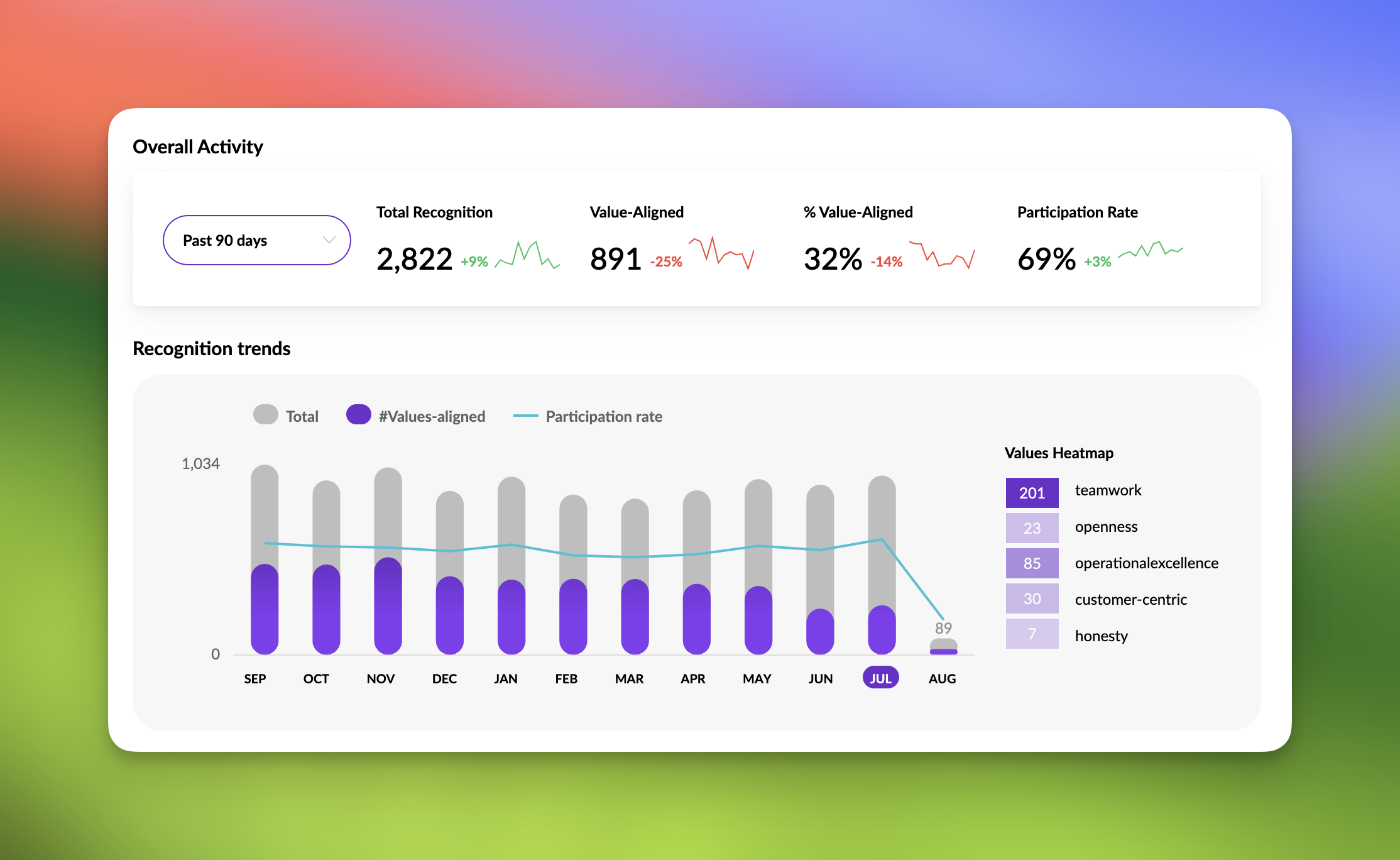Employee recognition programs are a crucial tool for fostering a positive work culture and driving engagement. However, many organizations struggle to align these programs with their core values, missing out on a valuable opportunity to reinforce desired behaviors and shape their culture. This article explores the importance of values-driven recognition and provides strategies for implementing effective programs that can transform organizational culture and performance.
The Power of Values-Driven Recognition
Reinforcing Desired Behaviors
By intentionally linking recognition to company values, organizations provide clear directionality for the recognition process. This approach transforms recognition from simply making people feel valued into a powerful mechanism for reinforcing the behaviors and mindsets that embody an organization's principles. When employees see their colleagues being recognized for actions that align with company values, it creates a ripple effect, encouraging others to emulate those behaviors.
Boosting Employee Satisfaction and Performance
Research demonstrates the significant impact of values-based recognition programs:
- 86% of such programs show an increase in worker satisfaction [1]
- Well-designed recognition programs can boost average employee performance by 11.1% [2]
- Organizations with strong recognition cultures are 12 times more likely to have strong business outcomes [9]
These statistics underscore the tangible benefits of aligning recognition with organizational values. When employees feel that their contributions are recognized in the context of broader company goals, they're more likely to feel a sense of purpose and engagement in their work.
Driving Cultural Alignment
Values-based recognition helps address a common challenge faced by many organizations: overestimating how well employees understand how each company value applies to their specific roles. By providing context and clarity around what excellence, innovation, or teamwork looks like in different job functions, recognition becomes a powerful tool for shaping culture and driving alignment [3].
This alignment is crucial for creating a cohesive organizational culture. When all employees, from entry-level to executive leadership, understand and embody the company's values, it creates a unified workforce that can more effectively pursue common goals and overcome challenges.
Implementing Effective Values-Driven Recognition
Clearly Define and Communicate Values
The foundation of successful values-driven recognition lies in clearly defining and communicating company values to the workforce. Employees must understand how their work contributes to and supports these values. This can be achieved through:
- Regular coaching and training sessions
- Value-oriented feedback
- Involving employees in the creation and review process of company values [2]
Additionally, organizations should consider creating a "values playbook" that provides concrete examples of how each value manifests in different roles and situations. This resource can serve as a guide for both managers and employees in understanding what behaviors align with company values.
Align Recognition with Specific Behaviors
To ensure recognition efforts are not arbitrary or ineffective, organizations should create a clear link between specific behaviors and company values. This involves:
- Identifying specific, measurable behaviors that drive business objectives
- Creating a clear link between these behaviors and company values
- Recognizing and reinforcing actions that exemplify these behaviors [2]
For example, if "innovation" is a core value, recognize employees who propose new ideas, take calculated risks, or find creative solutions to problems. This specificity helps employees understand exactly what behaviors are valued and encouraged.
Provide Role-Specific Context
Understanding how values apply to different roles is crucial for effective implementation. Organizations should:
- Develop role-specific examples of how each value manifests in different job functions
- Use these examples in recognition programs to provide context and clarity
- Regularly review and update these examples as roles and company priorities evolve [6]
This tailored approach ensures that all employees, regardless of their position, can see how they can embody company values in their daily work.
Leverage Technology and Social Recognition
Modern recognition platforms can enhance the effectiveness of values-driven programs. These tools can:
- Facilitate peer-to-peer recognition aligned with company values
- Provide real-time visibility into recognition trends across the organization
- Offer data-driven insights to measure the impact of recognition on key performance indicators [8]

By leveraging technology, organizations can create a more inclusive and transparent recognition culture, where employees at all levels can participate in acknowledging their colleagues' contributions.
The Impact of Values-Driven Recognition
Enhanced Employee Engagement
Consistently recognizing behaviors that align with company values can have a profound impact on employee engagement. This approach:
- Increases employee motivation and commitment
- Fosters a sense of purpose and connection to the organization's mission
- Improves overall job satisfaction and workplace morale [5]
Engaged employees are more likely to go above and beyond in their roles, contribute innovative ideas, and serve as brand ambassadors for the organization.
Improved Retention and Attraction of Top Talent
A strong, values-driven culture supported by recognition can significantly impact an organization's ability to retain and attract talent. Research shows that:
- 68% of employees would consider leaving their job if they didn't feel appreciated [10]
- Companies with strong recognition programs have 31% lower voluntary turnover rates [11]
- 79% of employees say recognition makes them work harder [12]
These statistics highlight the crucial role that values-driven recognition plays in creating an environment where top performers want to stay and contribute their best work.
Stronger Organizational Performance
Companies with strong, clearly articulated values outperform their peers. Values-driven recognition contributes to this by:
- Aligning individual and team efforts with strategic objectives
- Promoting behaviors that drive innovation and excellence
- Creating a more cohesive and collaborative work environment [7]
This alignment between individual actions and organizational goals can lead to improved business outcomes, increased innovation, and a stronger competitive position in the market.
Overcoming Challenges in Implementation
While the benefits of values-driven recognition are clear, organizations may face challenges in implementation:
- Resistance to change: Some employees or managers may resist new recognition practices. Address this by clearly communicating the benefits and providing training on how to recognize others effectively.
- Measuring impact: Develop clear metrics to measure the impact of your recognition program on employee engagement, retention, and business outcomes.
- Avoid favoritism: Implement checks and balances to ensure that recognition is fair and not influenced by personal relationships or biases.
By proactively addressing these challenges, organizations can create a more robust and effective values-driven recognition program.
Conclusion
In today's competitive talent landscape, organizations must prioritize creating a culture that attracts, engages, and retains top performers. By aligning employee recognition with company values, leaders can harness the power of positive reinforcement to shape behaviors, drive engagement, and build a thriving, values-driven culture.
To implement an effective, values-driven recognition program, organizations should clearly define and communicate their values, align recognition with specific behaviors, provide role-specific context, and leverage technology to support their efforts. By doing so, they can create a powerful tool for reinforcing desired behaviors, boosting employee satisfaction and performance, and driving overall organizational success.
The journey to creating a values-driven recognition culture is ongoing and requires commitment from all levels of the organization. However, employee engagement, retention, and organizational performance benefits make it a worthwhile investment for any company looking to build a strong, cohesive, and high-performing workforce.
If you would like to learn more about how Happily.ai can help your organization implement an effective, values-driven recognition program, please visit happily.ai.
References
[1] HRD Connect. (2024, May 24). The power of recognition programs for employee engagement. https://www.hrdconnect.com/2024/05/24/the-power-of-recognition-programs-for-employee-engagement/
[2] Motivosity. (n.d.). Rewards & recognition program. https://www.motivosity.com/blog/rewards-recognition-program/
[3] Talent Elevated LLC. (n.d.). Aligning employee recognition with company values. LinkedIn. https://www.linkedin.com/pulse/aligning-employee-recognition-company-values-talent-elevated-llc
[4] Bonusly. (n.d.). Company values. https://bonusly.com/post/company-values
[5] Vantage Circle. (n.d.). Recognition as a tool for reinforcing company values and objectives. https://www.vantagecircle.com/en/blog/recognition-as-a-tool-for-reinforcing-company-values-and-objectives/
[6] Birkman. (n.d.). Role clarity begins with the job description. https://birkman.com/resources/articles/role-clarity-begins-with-the-job-description
[7] Surmani, A. (n.d.). Developing & clarifying your company's core values. LinkedIn. https://www.linkedin.com/pulse/developing-clarifying-your-companys-core-values-andrew-surmani
[8] The Access Group. (n.d.). How social recognition helps align your people with organisational values. https://www.theaccessgroup.com/en-gb/access-applause-hub/how-social-recognition-helps-align-your-people-with-organisational-values/
[9] Bersin, J. (2012). New research unlocks the secret of employee recognition. Forbes. https://www.forbes.com/sites/joshbersin/2012/06/13/new-research-unlocks-the-secret-of-employee-recognition/
[10] Achievers. (2019). Engagement and retention report. https://www.achievers.com/resources/white-papers/achievers-workforce-institute-2019-engagement-and-retention-report/
[11] Gallup. (2016). Employee recognition: Low cost, high impact. https://www.gallup.com/workplace/236441/employee-recognition-low-cost-high-impact.aspx
[12] SurveyMonkey. (2019). The impact of employee recognition on business performance. https://www.surveymonkey.com/curiosity/impact-of-employee-recognition-on-business-performance/









